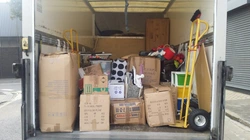How to Safely Pack Large and Bulky Furniture for a Move
Moving to a new home is an exciting adventure, but it often comes with the daunting challenge of relocating your most cumbersome possessions. Learning how to safely pack large and bulky furniture for a move not only protects your investments but also ensures a stress-free moving day. This comprehensive guide offers practical tips and professional advice to help you handle hefty couches, wardrobes, beds, dining sets, and more--so your furniture arrives in perfect condition.
Why Properly Packing Big Furniture Matters
Improperly handled furniture is vulnerable to scratches, dents, or worse--structural damage. Moreover, bulky items are not just valuable; they can also be tricky to maneuver and transport. Taking time to learn the best ways to securely pack oversized furniture for moving saves time, money, and heartbreak.
- Preserve value: Your furniture pieces represent a significant investment--proper preparation keeps them looking their best.
- Prevent injury: Packing techniques can help avoid personal harm during heavy lifting and carrying.
- Facilitate smooth transit: Well-packed furniture is easier to load, move, and unload, saving you effort on moving day.

Essential Materials for Packing Bulky Furniture
Before you begin, gather the right materials. Investing in appropriate packing supplies makes a world of difference in safeguarding your cherished pieces.
- Moving blankets or furniture pads: For cushioning and surface protection.
- Shrink wrap/plastic wrap: Prevent scratches and keep items together.
- Furniture sliders: Facilitate easy movement without damage to floors.
- Bubble wrap: For delicate elements and corners.
- Corrugated cardboard sheets: Add layers of protection.
- Packing tape and stretch tape: Secure wrapping materials.
- Disassembly tools (screwdrivers, Allen wrenches): To take apart large items when necessary.
- Plastic bags and labels: Store loose screws and hardware safely.
- Markers: For labeling disassembled parts.
Step-By-Step Guide to Packing Large Furniture for Moving
1. Take Inventory And Assess
Begin by walking through your home and listing all large and heavy furniture items you'll be moving. Assess each piece for damages, and take photos for peace of mind or insurance purposes. Consider if it's worth moving every item--bulky or damaged furniture might be better sold or donated.
2. Measure Doorways, Stairs, and Elevators
Before you start moving, make sure your large items can fit through all entry points in your old and new homes. Measure furniture dimensions and compare them with doorways, hallways, staircases, and elevator sizes. If necessary, consider partial or full disassembly.
3. Disassemble When Possible
The safest way to pack large furniture for a move is to break it down as much as possible. Remove legs from tables and sofas, take apart bed frames, detach drawers from dressers, and remove shelves from cabinets. This not only makes packing easier but also reduces the risk of breakage or injury.
- Keep screws, bolts, and other small parts in labeled plastic bags and tape them securely to the furniture or keep them in a moving essentials kit.
- Label each part and photograph the assembly process to make reassembly easier.
4. Clean Furniture Thoroughly
Clean each piece before wrapping it. Dirt and debris can cause scratches and may even transfer odor or pests to your new place. Wipe down surfaces with a mild cleaner and dry them thoroughly.
5. Protect and Wrap Each Piece
Wrapping is the heart of safe packing for large furniture. Here's how to do it right:
- Upholstered items: Cover in plastic wrap or fitted slipcovers to block dirt and spills, then add moving blankets for cushioning.
- Wooden furniture: Avoid direct plastic wrap, which can trap moisture and damage finish. Use blankets, wrap with bubble wrap for sharper corners, then secure with stretch tape.
- Glass surfaces: Remove whenever possible and wrap glass panels or table tops with thick cardboard, followed by bubble wrap and moving blankets.
Tip: Never tape directly onto furniture surfaces--adhesives can peel off finishes.
6. Use Sliders and Dollies
To prevent injuries and floor damage, place furniture sliders under heavy items before moving them. For larger loads, use a furniture dolly, which makes for smooth movement down hallways and onto the moving truck.
7. Secure Items for Transportation
Once loaded onto the moving truck:
- Position heavy furniture against the walls of the truck for stability.
- Stand sofas and mattresses on end when space allows.
- Tie down items with straps or ropes to prevent shifting during transit.
- Use moving blankets as barriers between stacked items.
Special Tips for Packing Different Types of Large Furniture
How to Pack Sofas and Couches
- Remove cushions and pack them separately in large bags.
- Take off legs or detaching sections if possible.
- Wrap the entire frame with moving blankets, securing with stretch film.
How to Safely Move Beds and Mattresses
- Disassemble bed frames and pack each component separately.
- Use mattress bags or covers for added hygiene and protection.
- Keep all bolts and fittings labeled in a sealed bag attached to the bed frame.
How to Prepare Dressers and Cabinets
- Remove drawers. Wrap them with cling film to keep contents secure, or empty them for easier lifting.
- Wrap the main frame with blankets, securing doors and handles.
- Place cardboard over glass doors or mirrors, then wrap in bubble wrap.
How to Move Dining Tables
- Remove table legs where possible and wrap individually.
- Wrap the tabletop with moving blankets, and reinforce corners with extra bubble wrap.
Moving Appliances Safely
- Unplug, clean, and dry all appliances well before the move.
- Secure power cords with twist ties and tape to the back of the appliance.
- Use appliance dollies and straps for stability during movement.
Common Mistakes to Avoid When Packing Heavy Furniture
- Skipping disassembly: Skipping this step risks breakage and injury.
- Insufficient wrapping: Unwrapped corners and surfaces are prone to gouges and rub marks.
- Overloading drawers or compartments: This makes items heavier and increases wear or breakage risk.
- Improper stacking in the truck: Avoid placing heavier items on top of lighter, fragile objects.
- Using inappropriate tape: Do not use duct tape on furniture; use packing tape over blankets for security.
When to Hire Professional Movers for Oversized Furniture
Although packing and moving large furniture safely can be a DIY project, certain situations call for a professional touch:
- Exceptionally large or valuable pieces (like pianos or antiques).
- Narrow entryways and multiple flights of stairs.
- Specialty items requiring hoisting or cranes.
If you feel uncomfortable, it's better to invest in professional movers to protect both your furniture and yourself.
Eco-Friendly Ways to Pack and Move Large Items
Packing furniture doesn't have to be wasteful. Try these eco-conscious tips:
- Reuse blankets and towels as padding.
- Rent reusable moving boxes and bins.
- Donate or sell unwanted furniture instead of sending it to landfill.
- Recycle packing materials after the move.

Frequently Asked Questions About Packing Large Furniture
How do I move large furniture through tight spaces?
Disassemble whenever possible. If necessary, tilt or rotate items, protect walls and corners with blankets, and measure all dimensions carefully. Remove doors if needed.
What is the best way to protect wood furniture in a move?
Use moving blankets and cardboard sheets instead of plastic wrap directly on wood, which can trap moisture. Bubble wrap is perfect for vulnerable edges and corners.
Should I empty all drawers?
For very heavy pieces, it's best to empty drawers. For lighter loads or shorter moves, they may be left in if well-secured with plastic wrap.
Can I move large furniture myself?
For very heavy or awkward items, enlist friends or hire professionals to avoid injury. Always use proper tools and lifting techniques.
Conclusion: Pack Large Furniture with Confidence
With attention, patience, and the right packing techniques, anyone can safely pack large and bulky furniture for a move. Use quality materials, take time to disassemble where possible, and protect every surface and corner. Don't hesitate to seek help with particularly difficult items--your safety and peace of mind are worth it. With these tips, you'll settle into your new space with all your favorite furniture intact and ready for use.
Ready for your move? Check out our other home moving tips for more expert advice!


